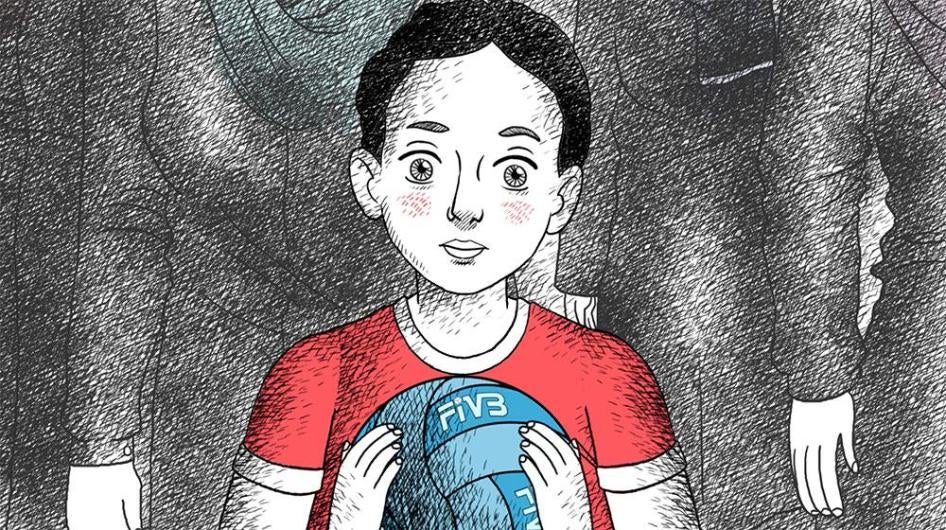At age 13, I was a huge fan of Iran’s national football team, and I was determined to cheer it on at the Nov. 2002 World Cup football qualifier in Tehran.
With the clock ticking on the final leg of the match with Kuwait, I remember repeatedly adjusting my long hair under a hat as my dad drove us to Azadi stadium. As victory edged nearer, I had hoped my makeshift disguise would convince my father that I too could join the 90,000-plus crowd cheering wildly – but alas, it was not to be. The Iranian government had ruled women and girls – half of Iran’s population – “out-of-bounds” in attending sporting events, like football matches, with serious consequences for those caught defying the ban.
When I was growing up in Iran, women mounted a number of popular initiatives, such as the “White Scarves” campaign, to challenge this blatant discrimination and demand that girls and women be able to attend male football games in Iranian stadiums. Even former president Mahmoud Ahmadinejad tried to lift the ban on women attending matches. But not only has this ban endured, it has now spread to afflict the increasingly popular sport of volleyball, where women have been banned from attending men’s games since 2012.
Meanwhile, volleyball has become one of Iran’s most popular sports. The national team just qualified for the Olympics in Rio de Janeiro, Brazil, with a string of big wins. Iranians obsessively follow the national team and go to stadiums wherever possible to cheer it on. But for women, the ban is still in place, separating women and girls from their families and friends when the team plays at home.
The International Federation of Volleyball (FIVB) may not be a household name like FIFA, the powerful football federation, but it controls volleyball across the world, and oversees the sport’s tournaments. At the international tournament last summer, Iranian women were shut out as Iranian authorities reneged on promises that women could attend, restricting ticket sales to men only. Security forces took up positions around the stadium, inspected approaching cars at checkpoints, and turned women away. Images of flyers published on social media showed political hardliners threatening to stop women from entering stadiums, and comparing any women who might attempt attendance to “prostitutes.”
This climate of fear and intimidation has been in place since 2014, when Ghoncheh Ghavami and several other Iranian women were arrested as they attempted to attend one of the volleyball matches at Azadi. While most were released soon thereafter, Ghavami was re-arrested, charged with “propaganda against the state,” and held in Evin prison for nearly five months.
Government authorities inside the country are divided on this issue, as the debate over the ban continues. Defenders of the restrictions argue that stadiums are too dangerous for women, or (completely unrelatedly) that women’s time is better spent doing household chores rather than watching volleyball.
Critics of the ban stress that the rights of half of the population cannot be denied without any clear legal basis. Last year, Shahindokht Mowlaverdi, the vice president for women’s and family affairs, said that the national security council had determined that women attending sport stadiums is not against Islamic law, and that a framework for their attendance should be created.
A major problem is that the FIVB has acquiesced to hardliners excluding women – the most regressive elements of the Iranian government – rather than backing the popular demands of Iran’s citizens. Despite the failure to allow women into stadiums in 2015, the FIVB awarded Iran the rights to host international matches, including the international beach volleyball tournament held this past February and the World League matches set to launch July 1.
For the Feb. 2016 matches, the FIVB announced that it had assurances from Iranian tournament organizers that the Kish Island Beach Volleyball tournament would “be open to fans from all age groups and genders,” and that this would “include families and women.” Yet (once again) the vast majority of women were turned away by people who appeared to be security forces. While Iran’s volleyball federation Twitter account and some domestic media outlets made sure to publicize the photos of a few, select women who were allowed to attend matches, women who were not allowed turned to social media and posted photos of themselves watching volleyball at a cafe facing the field. The FIVB appeared to side yet again with the hardliners by calling the exclusion of women a “slight misunderstanding.”
Today, three days before the Iran-Serbia match, tickets are being sold on Iran’s Volleyball Federation website (link in Persian), but not for women. The website says “women will not be able to purchase tickets since their quota is already filled.”
A new euphemism for gender discrimination is born every day in Iran, it seems, and the FIVB has yet to find its voice to defend women’s right to attend their tournaments.
Yet unlike the FIVB, Iranian women have not stopped their efforts to challenge the ban, with men teaming up with them to support the cause by holding up signs up in stadiums in solidarity – and sometimes refusing to attend games.
Nearly 13 years after I waved goodbye to my father as we parted ways outside of Azadi stadium, Iranian media reported that yet another 15-year-old girl who tried to get into the football stadium by dressing as a boy was arrested.
I understand why girls and women are taking real risks to watch a sport they love. But what is hard to grasp is why Iran, with a volleyball team that just qualified for the Olympics for the first time in history, is continuing a ban that not only is discriminatory but also generates waves of negative media coverage for the government and its own national sports teams. The moment to overturn the ban is now, before it is on ugly display again to the world on July 1.
Repealing the ban on women in stadiums would be a big win for women, and for progress in Iran. And it would show that in sports, as in human rights, the rules really do matter.







